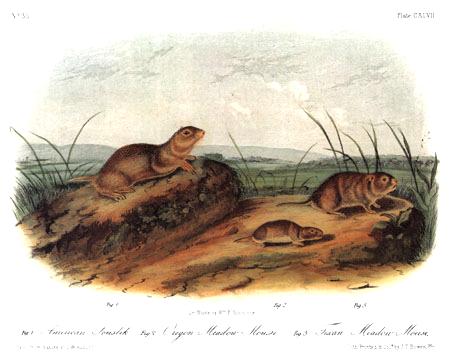

147 American Souslik, or Meadow Mouse
SPERMOPHILUS TOWNSENDII.---BACH.
AMERICAN SOUSLIK.
[Townsend's Ground Squirrel]
PLATE CXLVII. FIG. 1.---MALE.
S. Magnitudine Sciuri Hudsonii, capite parvo, corpore gracilior, auribus
caudaque brevibus, colore supra rufo-fusco griseo sparsim vario, infra
pallidiore.
CHARACTERS.
Size of Sciurus Hudsonius (red squirrel); head, small; body, rather
slender; ears and tail, short; colour, upper surface speckled with white and
brown; beneath, yellowish-gray.
SYNONYMES.
ARCTOMYS (SPERMOPHILUS) GUTTATUS ? --AMERICAN SOUSLIK. Rich., F. B. A.,
p. 162.
SPERMOPHILUS TOWNSENDII--TOWNSEND'S MARMOT. Aud. and Bach., Jour. Acad.
Nat. Sci. Phil., vol. viii., part 1, p. 61.
DESCRIPTION.
This animal has a convex and obtuse nose, with the frontal bone depressed;
the body is rather long and slender; head, short; ears, slightly visible above
the fur; cheek pouches, small; nails, slender, compressed, and slightly arched;
the thumb protected by an acute and prominent nail; the second toe of the
fore-foot, as in all the species of the genus, is longest, and not the third, as
in the squirrels. The first toe is a little shorter than the second, and the
third intermediate in length between the first and second. The tail appears (in
the dried specimen) much flattened; it is clothed with hairs which are longest
on the sides.
The fur is throughout remarkably soft, smooth, and lustrous.
COLOUR.
There is a line of white around the eye. The fur on the whole upper
surface is, for one fourth of its length from the roots, dark bluish, or nearly
black, then (a broad line of) silver gray, then (a narrow line of) dark brown
edged with yellowish-white, giving it a brownish-gray appearance, speckled with
white all over the back; these spots are longest near the dorsal line, becoming
smaller half way down the sides. An indistinct line of separation between the
colours of the upper and under surfaces appears high up along the hips and
sides; on the under surface, the hairs are nearly black at the roots, and are
cinereous at the tips; on the forehead, nose, and sides of the neck, there is a
slight tinge of light yellowish-brown. Tail, on the upper surface, light
yellowish-brown edged with whitish; beneath, whitish, with a slight tinge of
brown; teeth, white; nails, black.
DIMENSIONS.
Inches. Lines.
From point of nose to root of tail,. . . . 8 9
Head,. . . . . . . . . . . . . . 1 10
Tail (vertebrae),. . . . . . . . . . 1 0
Tail (to end of fur), . . . . . . . . 1 6
Length of heel to end of middle claw, . . . 1 4
HABITS.
In a letter addressed to us by the late Mr. TOWNSEND he states that this
handsome Spermophile, in summer inhabits the prairies near the Wallawalla, where
it is rather common; it becomes excessively fat, and is eaten by the Indians.
It disappears in August and re-appears early in spring, in a very emaciated
state. We have heard from other sources that it lives in small families, like
the Spermophiles, generally burrowing in holes, and that it is seen either
sitting on the side of them or with the head partially protruded, but disappears
in its underground retreat, on the approach of man or any other animal.
GEOGRAPHICAL DISTRIBUTION.
This species exists on the western sides of the Rocky Mountains in Oregon,
where the few specimens we have seen have been obtained.
GENERAL REMARKS.
RICHARDSON described this species under the name of A. guttatus, an animal
described by PALLAS (Glir. tab. 6 B) existing on the Wolga in Russia; but BUFFON
mentions of that species, that the name of Souslik is intended to express the
great avidity that animal has for salt, which induces it to go on board vessels
laden with that commodity, when it is often taken. We should judge that its
American relative has less opportunity of indulging in such a propensity. We
carried a specimen with us to Europe, and had an opportunity at the Berlin
Museum of comparing it with specimens from Siberia; there is a general
resemblance between the animals of the two countries, but they are scarcely more
alike than the red squirrel of Europe (Sciurus vulgaris) and the red squirrel of
America (Sciurus Hudsonius). They may be distinguished from each other at a
glance by the large rounded spots on the back of the Russian animal, compared
with the white and irregular specks in the American species.
As the name guttatus was preoccupied, we have named this animal anew, and
in doing so, called it after the gentleman who furnished us the specimen.
|